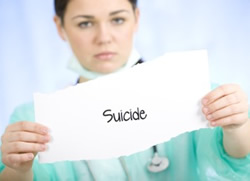 Last week the editor of a Rhode Island Patch asked me to write a blog article about suicide. The previous weekend a 48-year-old woman jumped off the Newport Bridge, taking her own life, and the community was in pain. The editor said it was a very public event, creating a newsworthy traffic jam. After posting the incident to Facebook, victim’s name omitted, she received a slew of emails asking her to say no more.
Last week the editor of a Rhode Island Patch asked me to write a blog article about suicide. The previous weekend a 48-year-old woman jumped off the Newport Bridge, taking her own life, and the community was in pain. The editor said it was a very public event, creating a newsworthy traffic jam. After posting the incident to Facebook, victim’s name omitted, she received a slew of emails asking her to say no more.
Was stigma behind these requests? I asked the editor what she was hearing.
Residents asked her not to cover the story – at all! They didn’t want the woman’s name mentioned, and they didn’t want to talk about it. The editor wrote to me that she thought an objective article (from an outsider) would contribute to the healing process, and maybe even open the discussion up a little.
I remember when a family friend’s son killed himself. The next day I was speaking with a colleague of one of his parents about an unrelated matter and I faltered. Should I reveal that her colleague’s son died? That he took his own life? I didn’t know. What would the public message be? As the editor of the Rhode Island Patch said to me, when someone dies from cancer or a car accident people speak freely. When it is suicide there are secrets.
The factors leading to the act of suicide are complex, as is the associated stigma. The shame isn’t just about the victim – it also impacts the victim’s family, friends and service providers. Society perceives one taking his own life as a weakness. It is seen as an inability to adequately deal with emotional problems: A failure. [i] The failure isn’t just the victim’s. Whether or not justified, the people involved in the victim’s life feel this weight too, asking themselves, “What more could I have done to prevent this final act?” [ii] [iii]
Suicide prevention comes down to balancing an individual’s risk factors (mental illness and trigger incidents) with their protective factors (access to therapeutic and social supports). Successful intervention programs counter risk factors with multiple protective factors. To be comprehensive, in addition to giving psychiatric and psychological support, cultural and environmental conditions should also be tackled.[iv] That might mean reaching out to a Hispanic community, not just with bilingual staff, but also partnering with religious leaders to address the stigma in the community. The partnership can lead to overcoming the fear and embarrassment felt by many who are reluctant to pursue behavioral health services, and increasing awareness with non-consumers to yield greater community support.
When implementing a suicide prevention program, including an evaluation plan from the onset will help maintain the integrity of the assessment and produce more reliable outcomes. This will prove beneficial on several fronts, including demonstrating efficacy and that the program is doing what intended during real-life implementation, needed for replication. Alternatively, it might show that it is not doing what was intended, and therefore requires some tweaking.[v] Either scenario will give the program credibility, an added bonus when seeking funding.
[i] U.S. Department of Health and Human Services. Mental Health: A Report of the Surgeon General. Rockville, MD: U.S. Department of Health and Human Services, Substance Abuse and Mental Health Services Administration, Center for Mental Health Services, National Institutes of Health, National Institute of Mental Health, 1999.
[ii] Ting, L., Jacobson, J., and Sanders, S. (2011). Perceived Stress among Mental Health Social Workers Who Work with Suicidal Clients. Social Work:56; 4,327-336.
[iii] Cvinar, J. G. (2005), Do Suicide Survivors Suffer Social Stigma: A Review of the Literature. Perspectives in Psychiatric Care, 41: 14–21.
[iv] Suicide Prevention Resource Center (2011). The Research Evidence for Suicide as a Preventable Public Health Issue. SPRC, Washington, DC.
[v] Suicide Prevention Action Network USA, Inc. (2001). Suicide Prevention: Prevention Effectiveness and Evaluation. SPAN USA, Washington, DC.

